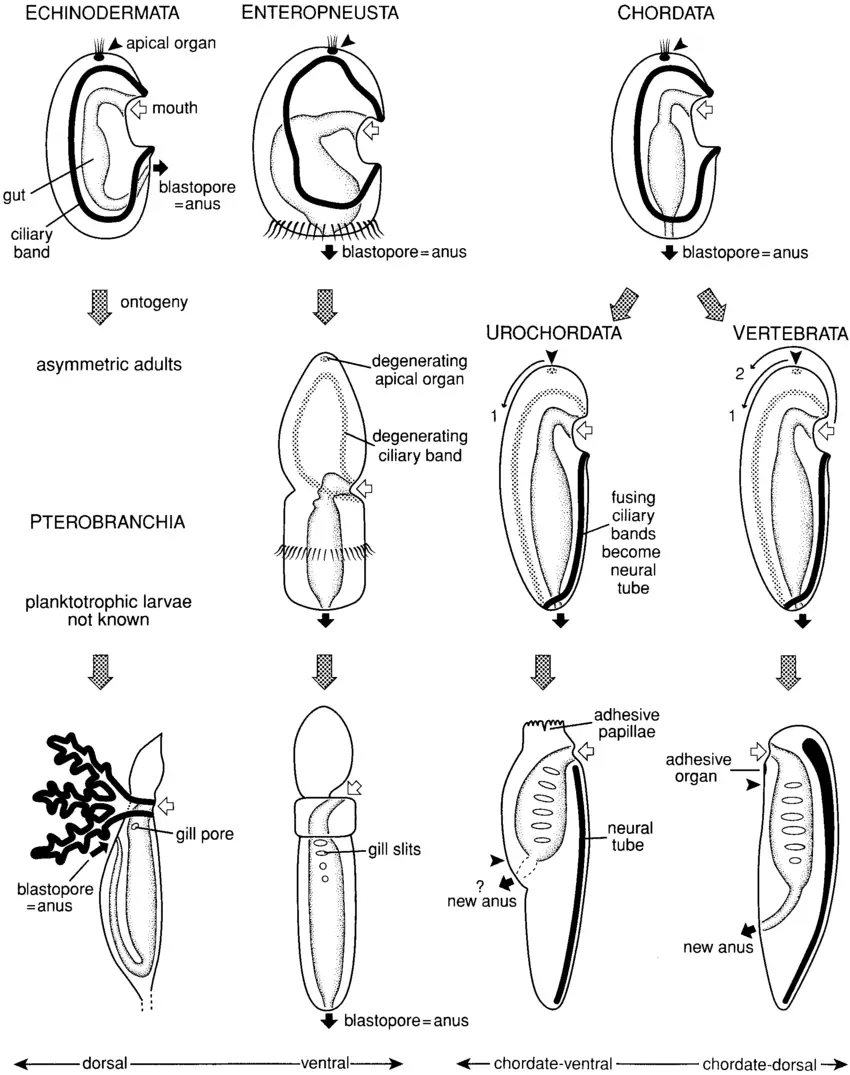Now we are going to discuss a very interesting topic on Chordata, origin, and Ancestry of Chordata and we will try to understand how Chordata first arrived on our earth.
In evolutionary trends, we know that simpler organisms give rise to more advanced forms, and in the case of Chordata most of the evidence points towards the non-chordate to be ancestors of phylum Chordata.
Due to lack of fossil evidence, it is very difficult to tell the actual timeline when exactly the phylum Chordata arrived on our earth, perhaps the early Chordata was soft-bodied so there is no fossil evidence.
But in late Cambrian strata, the vertebrate fossil was discovered so it is clear that vertebrates must have arrived during the late Cambrian or before and it is also clear that Chordata evolved before the late Cambrian.

So most of the scientists stated that Chordata evolved from invertebrates but those theories have great drawbacks but there is also some logic behind them and now we are going to discuss some of them.
If we study Echinodermata and Chordata carefully then it indicates that Chordata evolved from Echinodermata because there are close similarities between bipinnaria larvae of Echinodermata and tornaria larvae of hemichordates.
From this similarity, some scientists give their statements in favor of the evolution of Chordata from Echinodermata, according to their studies some free-swimming larvae of Echinodermata undergo paedogenesis.
Those free-swimming larvae start reproduction sexually without going through a metamorphosis, so through paedogenesis, some Echinodermata larvae evolved into Chordata.
Not only bipinnaria larvae, some other free-swimming larvae of Echinodermata, for example, auricularia larvae also show many similarities with Chordata and from those observations, Garstang and some other scientists think that the prolonged larval stage of those free-swimming larvae does not undergo into their adult stage through metamorphosis, instead, but they also started to reproduce sexually.
The event when the larvae do not undergo metamorphosis and they start sexual reproduction is known as paedogenesis and from this concept, a group of scientists stated that Chordata evolved from some free-swimming larvae of Echinodermata through the process of paedogenesis.

Above we have discussed the evolution of Chordata from Echinodermata now we will discuss a different opinion on the origin of Chordata.
Chordata shows many similarities with higher non-chordate and one of them is deuterostome. This similarity attracted some zoologists and this give rise to a new approach of thinking on the origin of Chordata.
Zoologist Romer, Berington study carefully different embryological and biochemical evidence, and they find that there is a common connection between Echinodermata, Hemichordata, and Chordata and this connection indicates that the three phyla Echinodermata, Hemichordata, and Chordata evolved from a common ancestor.
The Protochordata show similarity with both non-chordate and higher Chordate which indicates again a connecting link between Nonchordate and early members of Chordate.
Now we will focus on the whole timeline of evolution from ancestors of Chordata to different classes of phylum Chordata.

As we discussed earlier that we have fossil evidence of vertebrates of the late Cambrian period and before this timeline, there is no solid evidence of fossils that we can use to trace the timeline of the actual evolution of Chordata.
So we can say that Vertebrate was present on earth in the Cambrian period and after that, with time we find other fossil evidence for other groups of vertebrates.
In the Silurian period strata, we have fossils of fish and then in the Ordovician period, there are a large number of fish fossils which indicates that during this timeline fish evolved.
Then there is a lot of evidence that indicates that fish give rise to other groups of vertebrates, amphibians, reptiles, birds, and finally mammals.
Detailed Study on
Difference Between Chordata and Nonchordate
Phylum Chordata General Characteristics Features
Why Chordate are Advanced than Nonchordate
Chordate and Higher Non-chordates Similarity
Phylum Chordata 3 Fundamental Character
Phylum Chordata and Its Diversity
Chordata Definition with Examples
Resource: Chordata Origin and Ancestry
Hi Everyone!!! Welcome to Imaluop. Imaluop always try to learn some new and he want to share to other people. Here we will try to learn various topics on Science, specially on Biological Sciences.
